Granzyme B is not required for regulatory T cell-mediated suppression of graft-versus-host disease
- PMID: 19965675
- PMCID: PMC2832813
- DOI: 10.1182/blood-2009-07-233676
Granzyme B is not required for regulatory T cell-mediated suppression of graft-versus-host disease
Abstract
Regulatory T (T(reg)) cells can suppress a wide variety of immune responses, including antitumor and alloimmune responses. The mechanisms by which T(reg) cells mediate their suppressive effects depend on the context of their activation. We previously reported that granzyme B is important for T(reg) cell-mediated suppression of antitumor immune responses. We therefore hypothesized that granzyme B may likewise be important for suppression of graft-versus-host disease (GVHD). We found that allogeneic mismatch induces the expression of granzyme B in mixed lymphocyte reactions and in a model of graft-versus-host disease (GVHD). However, wild-type and granzyme B-deficient T(reg) cells were equally able to suppress effector T (T(eff)) cell proliferation driven by multiple stimuli, including allogeneicantigen-presenting cells. Surprisingly, adoptive transfer of granzyme B-deficient T(reg) cells prevented GVHD lethality, suppressed serum cytokine production in vivo, and prevented target organ damage. These data contrast strikingly with our previous study, which demonstrated that granzyme B plays a nonredundant role in T(reg) cell-mediated suppression of antitumor responses. Taken together, these findings suggest that targeting specific T(reg) cell-suppressive mechanisms, such as granzyme B, may be therapeutically beneficial for segregating GVHD and graft-versus-tumor immune responses.
Figures
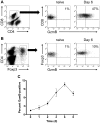

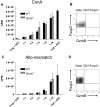
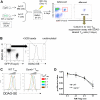
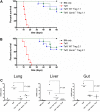
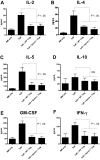

Comment in
-
Separation of GVHD and GVL.Blood. 2010 Mar 4;115(9):1666-7. doi: 10.1182/blood-2009-11-254946. Blood. 2010. PMID: 20203273 No abstract available.
Similar articles
-
Graft-versus-leukemia and graft-versus-host reactions after donor lymphocyte infusion are initiated by host-type antigen-presenting cells and regulated by regulatory T cells in early and long-term chimeras.Biol Blood Marrow Transplant. 2006 Apr;12(4):397-407. doi: 10.1016/j.bbmt.2005.11.519. Biol Blood Marrow Transplant. 2006. PMID: 16545723
-
Transplantation survival is maintained by granzyme B+ regulatory cells and adaptive regulatory T cells.J Immunol. 2008 Oct 1;181(7):4752-60. doi: 10.4049/jimmunol.181.7.4752. J Immunol. 2008. PMID: 18802078 Free PMC article.
-
Granzyme B-Mediated Activation-Induced Death of CD4+ T Cells Inhibits Murine Acute Graft-versus-Host Disease.J Immunol. 2015 Nov 1;195(9):4514-23. doi: 10.4049/jimmunol.1500668. Epub 2015 Sep 21. J Immunol. 2015. PMID: 26392464 Free PMC article.
-
Modulation of graft-versus-host disease: role of regulatory T lymphocytes.Biol Blood Marrow Transplant. 2006 Jan;12(1 Suppl 2):13-21. doi: 10.1016/j.bbmt.2005.11.002. Biol Blood Marrow Transplant. 2006. PMID: 16399597 Review.
-
Insights into the pathogenesis of GvHD: what mice can teach us about man.Tissue Antigens. 2015 Jan;85(1):2-9. doi: 10.1111/tan.12497. Epub 2014 Dec 23. Tissue Antigens. 2015. PMID: 25532439 Review.
Cited by
-
Granzyme B Contributes to the Optimal Graft-Versus-Tumor Effect Mediated by Conventional CD4+ T Cells.J Immunol Res Ther. 2016;1(1):22-28. Epub 2016 Apr 30. J Immunol Res Ther. 2016. PMID: 27774524 Free PMC article.
-
Serine protease inhibitor 6 plays a critical role in protecting murine granzyme B-producing regulatory T cells.J Immunol. 2013 Sep 1;191(5):2319-27. doi: 10.4049/jimmunol.1300851. Epub 2013 Aug 2. J Immunol. 2013. PMID: 23913965 Free PMC article.
-
In vivo administration of hypomethylating agents mitigate graft-versus-host disease without sacrificing graft-versus-leukemia.Blood. 2010 Jul 8;116(1):129-39. doi: 10.1182/blood-2009-12-257253. Epub 2010 Apr 27. Blood. 2010. PMID: 20424188 Free PMC article.
-
Cytotoxic Pathways in Allogeneic Hematopoietic Cell Transplantation.Front Immunol. 2018 Dec 19;9:2979. doi: 10.3389/fimmu.2018.02979. eCollection 2018. Front Immunol. 2018. PMID: 30631325 Free PMC article. Review.
-
Donor regulatory T cells rapidly adapt to recipient tissues to control murine acute graft-versus-host disease.Nat Commun. 2024 Apr 15;15(1):3224. doi: 10.1038/s41467-024-47575-z. Nat Commun. 2024. PMID: 38622133 Free PMC article.
References
-
- Sakaguchi S, Fukuma K, Kuribayashi K, Masuda T. Organ-specific autoimmune diseases induced in mice by elimination of T cell subset: I. Evidence for the active participation of T cells in natural self-tolerance: deficit of a T cell subset as a possible cause of autoimmune disease. J Exp Med. 1985;161:72–87. - PMC - PubMed
-
- Sakaguchi S, Sakaguchi N, Asano M, Itoh M, Toda M. Immunologic self-tolerance maintained by activated T cells expressing IL-2 receptor alpha-chains (CD25): breakdown of a single mechanism of self-tolerance causes various autoimmune diseases. J Immunol. 1995;155:1151–1164. - PubMed
-
- Kim JM, Rasmussen JP, Rudensky AY. Regulatory T cells prevent catastrophic autoimmunity throughout the lifespan of mice. Nat Immunol. 2007;8:191–197. - PubMed
-
- Fontenot JD, Rudensky AY. A well adapted regulatory contrivance: regulatory T cell development and the forkhead family transcription factor Foxp3. Nat Immunol. 2005;6:331–337. - PubMed
Publication types
MeSH terms
Substances
Grants and funding
LinkOut - more resources
Full Text Sources
Molecular Biology Databases

